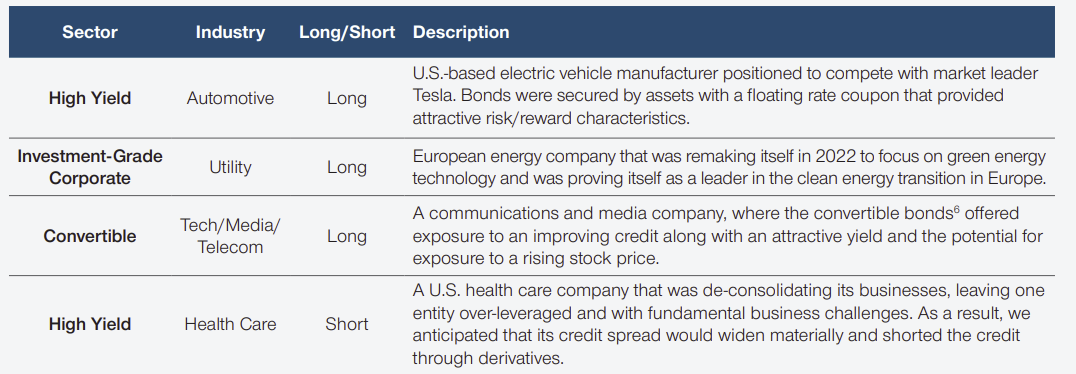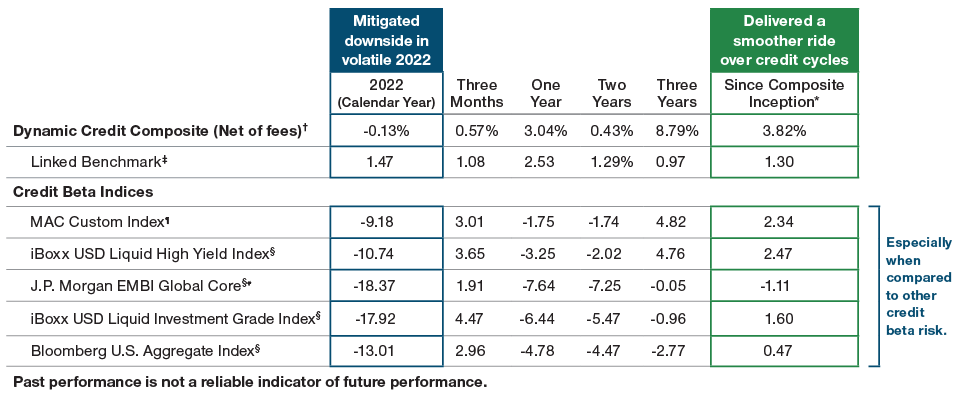May 2023 / INVESTMENT INSIGHTS
Smoothing the Ride for Credit Allocations
Dynamic Credit Strategy offers a flexible, differentiated approach
Key Insights
- The Dynamic Credit Strategy is well suited for those who want to take advantage of credit opportunities while also seeking a “smoother ride.”
- The strategy focuses on credit selection and sector rotation to generate alpha, coupled with active duration and credit beta management..
- The composite within the Dynamic Credit Strategy posted a nearly flat return in 2022, demonstrating the value of its approach in a historically difficult year for credit markets.
The Dynamic Credit Strategy seeks to offer investors a “smoother ride” in credit investing by finding diverse alpha1 sources in a variety of market environments. The strategy focuses on credit selection and sector rotation across the credit spectrum—high yield, investment grade, emerging markets, securitized, distressed, municipals, convertibles, and bank loans—of the global multi‑asset credit (MAC) universe.
The strategy harnesses expertise across T. Rowe Price’s global multi-sector research platform to deliver an actively managed, flexible portfolio with a long2 bias. Coupled with this long bias, which is expected to deliver 80% of the strategy’s returns, we employ active credit shorting3 and duration4 management in looking to add further alpha and dampen volatility. Our strong emphasis on finding credit dislocations, our total return perspective, and our goal of creating a differentiated portfolio are embedded in the design and the process of the strategy.
Key Source of Differentiated Returns
In addition to the strategy’s goal of delivering alpha across the broad credit market, we also strive to limit undue credit beta and duration risk. We believe that our approach to portfolio construction makes the strategy a compelling and consistent credit allocation, and its differentiated returns also enable it to complement other credit allocations. The strategy’s lower credit beta profile should allow it to hold up well in environments where credit spreads5 are widening, while its lower duration profile should be a positive in rising interest rate environments.
Credit Exposure: Creating a Better Way
(Fig. 1) Strategy strives for more flexible, alpha-oriented outcomes

Source: T. Rowe Price.
Green icons represent expected outperformance versus credit beta; red icon represents expected underperformance. The expected performance for Dynamic Credit is relative to alternative credit indices such as investment grade corporates, high yield corporates, or emerging market bonds. Market environments and expected performance are based on the general strategy structure, but are not based on actual performance, nor intended as forward-looking performance projections. As with any investment, performance may vary and is subject to potential loss. Actual performance may differ significantly.
For illustrative purposes only.
Spotlight on Credit Research
The strategy’s repeatable process relies heavily on our global research platform of more than 300 people, who collaborate across investment strategies, asset classes, and geographies. Our team of credit analysts integrates proprietary environmental, social, and governance (ESG) factors as appropriate into the analysis. The table below provides examples of typical types of positions:

For illustrative purposes only. It s not intended to be investment advice or a recommendation to take any particular investment action.
As of March 2023. Subject to change.
Three Primary Credit Evaluation Factors
When collaborating with our credit sector experts and evaluating individual credits for potential portfolio inclusion as either long or short positions, we ask three key questions:
- Is there a catalyst that could cause the credit to outperform? Depending on the type of credit, this could be a range of factors, such as a potential credit rating upgrade or downgrade for a corporate credit. For consumer‑dependent credit like an asset-backed security (ABS) backed by auto loans, it could be an upturn in consumer payment trends.
- Is the position positively or negatively correlated7 with the performance of existing portfolio holdings? A meaningful negative correlation could indicate that the new position can provide diversification benefits by gaining when other exposures lose value.
- What is the asymmetry of the return profile? Essentially, will the price benefit more from a positive development than it suffers from a negative outcome—or vice versa? This can affect how a holding would fit into the strategy’s overall positioning in terms of sizing, diversification, and potential alpha generation.
Performing as Expected
(Fig. 2) Dynamic Credit Fund held up in volatile 2022

Past performance is not a reliable indicator of future performance.
As of March 31, 2023. Figures calculated in U.S. Dollars. All percentages for time periods greater than one year are annualized.
Sources: T. Rowe Price and Bloomberg Finance L.P.
*January 31, 2019.
† Net of fees performance reflects the deduction of the highest applicable management fee that would be charged based on the fee schedule contained within this material, without the benefit of breakpoints. Net performance returns reflect the reinvestment of dividends and are net of all non-reclaimable withholding taxes on dividends, interest income, and capital gains.
‡ Effective May 1, 2021, the benchmark for the composite changed to the ICE BofA 3-Month Treasury Bill Index. Prior to May 1, 2021, the benchmark was the 3 Month LIBOR in USD Index. Historical benchmark representations have not been restated.
§ Indexes shown represent beta credit returns and are benchmarks used by ETFs: High Yield Bond, Emerging Market Bond, US Investment Grade Index and Bloomberg US Aggregate Bond Index, respectively. The ETF benchmarks are shown for illustrative purposes to demonstrate how each of the different sectors performed for the period when looking at passive indexes (peer proxies).
¶ MAC Custom index is represented by 1/3 Bloomberg US Corporate High Yield Bond Index, 1/3 S&P/LSTA Leverage Loan Index and 1/3 Bloomberg Emerging Markets Hard Currency Aggregate Index. The MAC benchmark is a TRP proprietary benchmark that is used to compare the MAC sectors against a comparable benchmark. Please see Additional Disclosures page for information about this S&P information and this Bloomberg information.
# Information has been obtained from sources believed to be reliable but J.P. Morgan does not warrant its completeness or accuracy. The index is used with permission. The Index may not be copied, used, or distributed without J.P. Morgan’s prior written approval. Copyright © 2023, J.P. Morgan Chase & Co. All rights reserved
In addition to addressing these three factors, our investment process tries to ensure that we are getting paid for each position’s embedded credit beta,8 volatility, and liquidity. Our dynamic, flexible, and alpha-oriented approach has enabled the composite to deliver differentiated performance in challenging markets such as in 2022, when traditional credit sectors suffered amid rapidly rising rates.
Approach Well Suited for Unsettled Credit Environment
The strategy’s alpha-seeking but risk‑aware approach is well suited for a range of market conditions, but it may be even more valuable in the current unsettled credit environment. We believe that our fundamental credit analysis process that generates forward-looking insights from a global research platform with broad sector expertise can help the strategy identify and capitalize on inefficiencies ahead of the market.
What We’re Watching Next
We have recently observed that banks are tightening their lending standards, which typically precedes the end of a credit cycle and rising defaults by two to three quarters. This changing environment may produce opportunities across the range of credit markets.
IMPORTANT INFORMATION
This material is being furnished for general informational and/or marketing purposes only. The material does not constitute or undertake to give advice of any nature, including fiduciary investment advice, nor is it intended to serve as the primary basis for an investment decision. Prospective investors are recommended to seek independent legal, financial and tax advice before making any investment decision. T. Rowe Price group of companies including T. Rowe Price Associates, Inc. and/or its affiliates receive revenue from T. Rowe Price investment products and services. Past performance is not a reliable indicator of future performance. The value of an investment and any income from it can go down as well as up. Investors may get back less than the amount invested.
The material does not constitute a distribution, an offer, an invitation, a personal or general recommendation or solicitation to sell or buy any securities in any jurisdiction or to conduct any particular investment activity. The material has not been reviewed by any regulatory authority in any jurisdiction.
Information and opinions presented have been obtained or derived from sources believed to be reliable and current; however, we cannot guarantee the sources’ accuracy or completeness. There is no guarantee that any forecasts made will come to pass. The views contained herein are as of the date noted on the material and are subject to change without notice; these views may differ from those of other T. Rowe Price group companies and/or associates. Under no circumstances should the material, in whole or in part, be copied or redistributed without consent from T. Rowe Price.
The material is not intended for use by persons in jurisdictions which prohibit or restrict the distribution of the material and in certain countries the material is provided upon specific request. It is not intended for distribution to retail investors in any jurisdiction.
